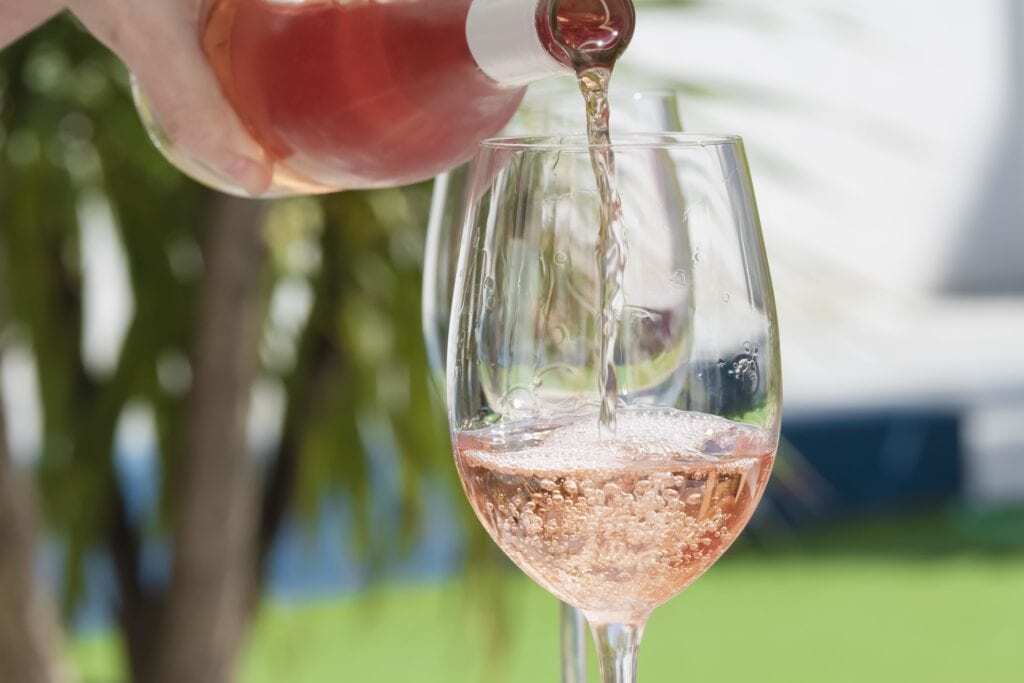Everything you need to know about the pink drink!

Blushing a gentle pink, redolent with the fragrances of rose petals and fruit with an occasional hint of earthy celery or tangy rhubarb… This is rosé, the wine of summer picnics, romantic evenings, and modern celebrations.
Exactly What Is Rosé Wine?
Rosé wines are in a class of their own. In color, they range from the subtlest of pink to deep raspberry. Flavors range from light and tangy to full and fruity or rich and savory. Nearly any grape that produces red wine can also be used to make rosé but most winemakers have a particular favorite. Like reds, the flavors of rosé will depend on the grape varietal (or varietals) used to make it. Since rosé wines are specifically made to be enjoyed for their fresh and fruity flavor, they’re generally sipped while they’re young, rather than waiting for them to age.
Flavors can range from mild (honeydew melon, strawberry, lemon, and celery) to bold (cherry, plum, blackberry, and orange zest). Other flavor notes found in various rosés include:
- apricot
- black currant
- blood orange
- cotton candy
- crabapples
- green bell peppers
- green melon
- hibiscus
- honeysuckle
- peach
- pink grapefruit
- pomegranate
- raspberry
- watermelon
Occasionally, you might also detect hints of allspice, green olives, green peppercorns, meatiness, smoke, tomato, violets, and white pepper.
How is Rosé Wine Made?
Now that we know what rosé wine it, its time to find out how it is made. Many people believe rosé wine is made by mixing white and red wines together to get that lovely shade of pink. There are pink wines made that way, but they aren’t rosés. These blended wines are called ‘blush wines’ (or ‘rotlings’ in German) and Württemberg’s Schillerwein and Baden’s Rotgold are prime examples of white wines mingled with a little red.
Others believe that rosé wines are made from a mixture of white and blue grapes being pressed and then fermented together. Wrong! That’s actually an example of how not to make rosé wine. In fact, wines made this way can’t even legally be called rosés.
And we probably shouldn’t even mention the people who believe that a non-existent pink grape produces such a pretty and delicious pink wine!
Actually, It’s All a Matter of Timing
To understand how rosé wine is produced, it’s helpful to know how red and white wines get their color (or lack of color). If you’ve ever cut a grape in half, you know that hiding beneath that colorful skin is a pale interior. In fact, most grape interiors are basically colorless. All of their color resides in the skin. What happens to the skin during the fermentation process determines the color of the wine.
Did you know that red wines are produced from blue grapes? That’s right, the skin of those blue grapes actually contains a mixture of both blue and red pigments. When the grapes are intact, they look blue, However, crushing them releases the red pigment and the resulting wine is red. Pink rosé wines are made from blue grapes, too!
Mash fermentation (red wines)
The whole grape is fermented, skin and all. The red and blue pigments from the skins give red wines their deep, rich red color as they macerate in the vats together, usually for several weeks. This method is common in the important rosé making region of Provence in France.
Rosés from this region are distinguished by their pale, orangy-pink color and delicate dryness. They’re generally considered to be premium rosés and are often (although not always) priced to match that perception!
Fun fact: The French drink more rosé wines now than they do white wines.
Must fermentation (white wines)
The grape skins are removed before fermentation. Without the skin pigments, the wine is the same pale color as the grape’s interior.
So, how do rosé wines get their pretty pink coloration?
By carefully timing the mash fermentation! It takes several weeks of fermentation for red wines to acquire all of that lavish coloring. At a few hours in, the grapes are just starting to release their pigments. Once they’re the preferred shade of pink, they’re pressed and the juice finishes fermenting in a clean vat.
The skins are generally allowed to stain the juice for anywhere from two to twenty hours, which accounts for the wide range of pinks found in different rosés. Without the skins releasing additional pigment, rosé wines will stay the same shade of pink they were when the process was interrupted.
Some rosés help make a better red
There’s another method of making rosé that not only makes a wonderful rosé but it also makes better red wine, too! This method is called Saignée or ‘bled’ wine. It all starts with a vat of red wine. After it has macerated for a few hours, part of the juice is bled off to produce rosé.
This helps concentrate the flavor of the remaining juice in the original vat. The end result is often a superior red. This might be one reason why some of the red wines from Sonoma and the Napa Valley are so renowned. However, this is the least common method of making rosés, since it produces a reduced yield of both the rosé and the red wine.
A Champagne of Another Color…

Some higher-end rosé champagnes are still produced by the traditional rosé winemaking method. However, most rosé champagne is made by mixing a little red wine into the champagne for a prettier color and a more rounded flavor. Rosé champagne is the only blended pink wine that can legally carry the rosé label and to earn that label it must be made in the Champagne region of France.
How to Drink Rosé
Wines smell and taste different at different temperatures. Serving a wine at the wrong temperature can dramatically affect how much you enjoy it. Like white wine, rosé should be served chilled. Just don’t serve it frosty! Instead, it should be enjoyed at around 50 – 60°. The exception to this rule is Syrah rosé, which tastes more like a red and should be served at a slightly warmer temperature than its sibling rosés.
Since they are served cold, rosé wines are the darlings of al fresco dining in the summer. A picnic, barbeque, or dessert under the stars wouldn’t be the same without a bottle or two of rosé wine.
This chilly temperature range lets all of a rosé’s delicious aromas and flavors shine.
The Varietals
Most rosés are blended wines made from several wine grape varietals blended together. Grenache grapes usually form the bulk of the blend, with varying amounts of other varietals mixed in to give the wine added flavor and body. Those other varietals might consist of some combination of:
- Cabernet Sauvignon ops
- Carignan
- Cinsault
- Mourvèdre
- Sangiovese
- Syrah
- Tibouren
The most popular rosé blend in Provence is Grenache along with Cinsault, Mourvedre, and Syrah grapes. California, on the other hand, is known for its single varietal dry rosés consisting of 100% Pinot Noir grapes.
Different ‘styles’ of rosé
Specific ‘styles’ of rosé wines occur when a rosé becomes strongly associated with a particular varietal of wine grape. Each different style develops its own unique flavor profile that is determined (in part) by that particular varietal.
Do You Prefer a Dry or Sweet Rosé Wine?
That question is largely a matter of taste. Rosés can range from profoundly acidic to incredibly sweet. Most rosés (especially those from Europe) are on the bone dry side.
Most New World rosés tend to be sweeter and ‘fruitier’. Whatever your taste in wine, there’s probably a rosé to suit it!
Tavel Rosé is an example of a very dry rosé wine, while Zinfandel Rosé (White Zinfandel) is an example of an extremely sweet one. White Merlot and Pink Moscato are two other popular sweet rosés.
Tannins are responsible for the mouth-puckering astringency, dryness, and slight bitterness associated with dry wines. A high tannin content, along with a lack of sugar, is responsible for a wine’s dryness. That kind of dryness in rosés comes mainly from the Carignan, Cinsault, Grenache, Mourvèdre, Pinot Noir, Sangiovese, and Syrah grape varietals used to make it.
Rosé pairings

Sweet rosés pair perfectly with hearty foods like barbecued meats, roasts, and rich sauces.
For dry rosés, lighter foods such as grilled chicken or fish, salads, and vegetables make for a great pairing.
Spicy foods practically cry out for any kind of rosé!
Join Me as We Sip Our Way Through More Fascinating Facets of Wine
The world of wines and wine history is always intriguing and inviting. Join Carpe Travel’s email list, and we’ll explore this fascinating world together. From learning about different wines to famous wineries, from the history of wine to sustainable viticulture, we’ll explore everything the world of wine has to offer. I can’t wait until we start our journey together!
Elaine Schoch is an award-winning travel writer, wine judge, American Wine Specialist and certified by the Wine & Spirit Education Trust (WSET II). At Carpe Travel she shares wine travel destination guides for ALL WINE LOVERS – from novices to experienced pros – to help them plan their wine adventures, arming them with insider tips, must-visit spots, and things to see and do beyond the vines.

